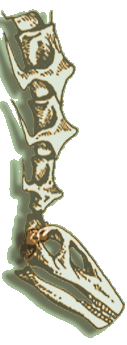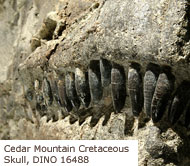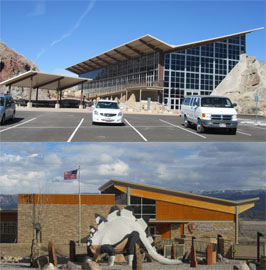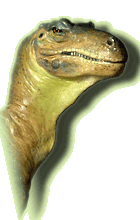| This multi-media exhibit gives you an intimate look at the remarkable fossils of Dinosaur National Monument.
· Look at the fossil specimens exposed on the cliff face of the Douglass Quarry at Dinosaur National Monument.
· Join a paleontologist; from finding a specimen in the field; to transport by helicopter back to the lab; and preparation for study and exhibit by clicking on the multimedia button.
· Enter an artist's conception and experience what Dinosaur National Monument looked like nearly 150 million years ago.
· Use the detailed charts to better understand these amazing creatures.
· Click on the Douglass Quarry, classification, adaptation, and environment themes to see specimens that illuminate these topics; and on stratigraphy and geologic time to learn more.
|
 |
 |
Dinosaur National Monument protects a large deposit of fossil bones of creatures that lived nearly 150 million years ago. The fossils help us learn more about these fascinating animals.
Dinosaur National Monument is special because visitors can see fossils exposed on the cliff face of the Douglass Quarry at the park visitor center. This site provides one of the best snapshots of Jurassic dinosaurs found anywhere in the world. The quarry was named after Earl Douglass, the paleontologist who found it.
From 1909 through 1924, when work focused on excavating museum specimens, the Douglass Quarry produced more:
· complete dinosaur skeletons;
· well-preserved dinosaur skulls;
· juvenile dinosaurs specimens;
· and different kinds of dinosaurs
than any other single site. Fossils from the Douglass Quarry are displayed in the Carnegie Museum, Smithsonian Institution, Washington, Denver Museum of Natural History, and in many other American museums.
Most great fossil deposits have been excavated until there's nothing left to see. That is not the case at Dinosaur National Monument. The National Park Service reopened the Douglass Quarry in the 1950s, not to remove all the fossils, but to develop them into a unique exhibit. The Douglass Quarry is enclosed within the park visitor center and museum. It offers visitors a unique opportunity to see over 1,400 fossil bones that have been left in place as nature deposited them 150 million years ago.
|
 |










